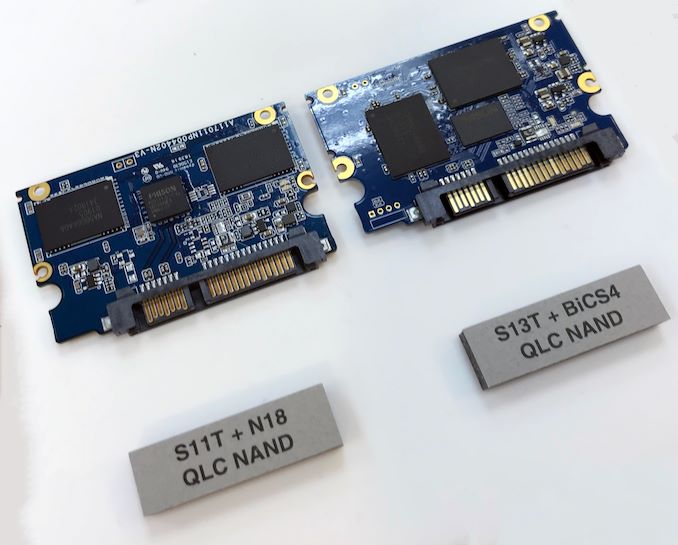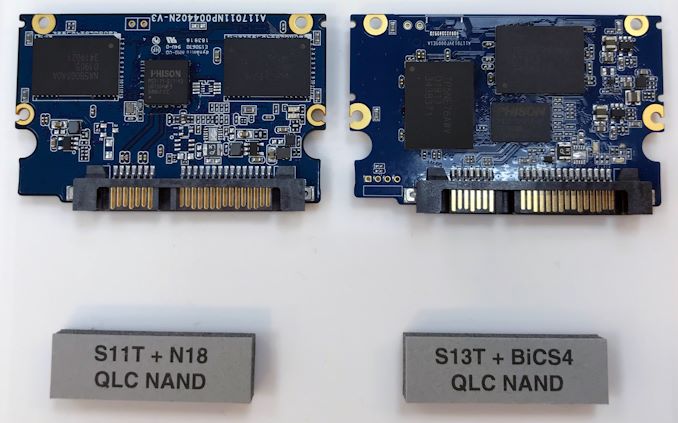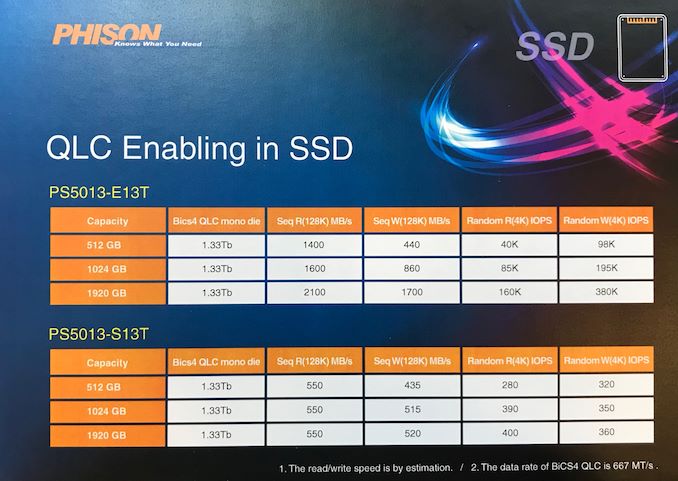Phison Demonstrates Turnkey SSDs Based on 3D QLC NAND
by Anton Shilov on June 21, 2019 3:00 PM EST
3D QLC NAND promises to become a significant phenomenon on the consumer SSD market thanks to its relatively low cost per gigabyte, further pushing down already dropping SSD prices. As one of the leading suppliers of turnkey SSDs, Phison for its part demonstrated QLC SSD prototypes at this year's Computex, using QLC NAND from both Micron and Toshiba.
To date, Phison has validated three of its controllers for use with 3D QLC NAND flash memory: two SATA controllers and one PCIe controller. The PS3111-S11T and PS3113-S13T are aimed at entry-level SATA SSDs, whereas the PS5013-E13T is designed for inexpensive PCIe 3.0 x4 NVMe drives. The S13T and the E13T support Phison’s 4th Generation implementation of LDPC-based ECC as well as other modern features designed to prolong endurance of SSDs and improve their performance, which are critical components to making QLC SSDs viable on the market.
As these are all prototypes of low-end drives, Phison isn't promising much in the way of performance; but then that's part of the tradeoffs that come with low-end hardware. Realistically speaking, PCIe SSDs will feel this pinch the most, as as cheap, low-capacity drives will use just a couple of NAND chips, limiting their ability to take advantage of parallelism. Meanwhile, for SATA drives the interface itself limits performance of modern NAND flash, so 3D QLC's performance limits are a lot less obvious. All told, the performance numbers below speak for themselves, with the 512 GB 3D QLC-based SATA looks set to offer up to 550 MB/s sequential read speeds as well as up to 435 MB/s sequential write speeds.
The following combinations of controllers and 3D QLC NAND chips has been validated by Phison. Eventually, the list and the number of combinations will be expanded.
- PS3111-S11T + N18
- PS3113-S13T + BiCS4
- PS5013-E13T + BiCS4 1.33 Tb
Since Phison demonstrated its turnkey 3D QLC-based SSDs at Computex, expect actual products to show up on the market later this year or early in 2020. MSRPs will, of course, depend on the price of 3D NAND at the time, as well as market demand for QLC SSDs.
| Want to keep up to date with all of our Computex 2019 Coverage? | ||||||
 Laptops |
 Hardware |
 Chips |
||||
| Follow AnandTech's breaking news here! | ||||||












12 Comments
View All Comments
nandnandnand - Friday, June 21, 2019 - link
Nice to see more 1.33 Tb NAND. Any 1.5 Tb and above yet?PeachNCream - Saturday, June 22, 2019 - link
Excellent! I can't wait to have less than 1K P/E cycle endurance per cell in my computer. It'll be almost as much fun as current gen 3D TLC's sh*tastic 3K P/E endurance! What fun!The_Assimilator - Saturday, June 22, 2019 - link
Oh shut up, you moron. Do you really think manufacturers would be selling products with 5-year warranties if they thought said products would fail within that time, thus causing them massive financial issues due to returns?This "boo hoo <new flash type> has fewer PE cycles than <previous flash type> and MY LIFE IS OVER AS A RESULT" idiocy has been happening since SLC was replaced with MLC. Guess what, none of those doomsday predictions have come to pass - and they won't, because the people designing NAND flash are a lot smarter than you and all the other dipshits making predictions about the lifetime of flash memory without knowing anything about it.
mariush - Saturday, June 22, 2019 - link
I guess some people are used with mechanical drives lasting 10+ years.They have to get used to upgrading more often or replacing drives.
I've bought my Sandisk X400 SSD (128 GB MLC drive) in March 2016 and paid around 60-70 dollars for it - now three years later a 120 GB drive is around 25$
So I could see it as paying 30-40$ every 2 years instead of paying 100$ for something that would last 5+ years.
Downside ... more waste (all the plastic shells/cases of SATA SSDs being thrown out), more pollution due to shipping products all over the world... but people want cheap stuff, race to the bottom...
Guspaz - Saturday, June 22, 2019 - link
Most people don't need crazy high PE cycles. I bought a 1TB 850 EVO 2.5 years ago, using it as my main system drive, and I've written 21TB to it over that time. I don't know how various factors in there would impact PE cycles, because on the one hand there's potential inefficiencies in wear leveling and write amplification, but on the other hand, there's the SLC cache. If we assume that means 21 PE cycles consumed, even a drive with a mere 100 PE cycles would last me more than a decade, and that seems fine for consumer use.Ten years on, you'd be able to get a faster SSD of the same capacity at a fraction the price. Heck, even in the 2.5 years since I've owned the drive, you can get a Samsung 860 EVO for 2/3 of what I paid, or a budget SSD for 1/3.
PeachNCream - Sunday, June 23, 2019 - link
Its funny that when you feel threatened by the numbers, you lash out at the person stating the numbers because you can't figure out where else to direct your aggression and cannot stop to process your feelings before letting yourself take a angry mental rage dump here, misquoting and railing solely to help yourself feel better.NewMaxx - Sunday, June 23, 2019 - link
Actually, BiCS4 is rated up to 1,500 P/E which with a typical consumer WAF could have some of these SKUs exceeding 1PB written. DRAM-less so probably much less, but it's still far in excess of what most people will be writing. And actually good 3D TLC - Intel/Micron or Samsung - will hit 10K+ P/E in practice.ajp_anton - Saturday, June 22, 2019 - link
Why does the SATA version have much higher random IOPS?nevcairiel - Sunday, June 23, 2019 - link
Its actually much lower IOPS, the PCIe variant is "40k", the SATA variant only mere 280 - the magic of NVMe, I assume.hojnikb - Sunday, June 23, 2019 - link
280IOPS? I HIGHLY doubt that.